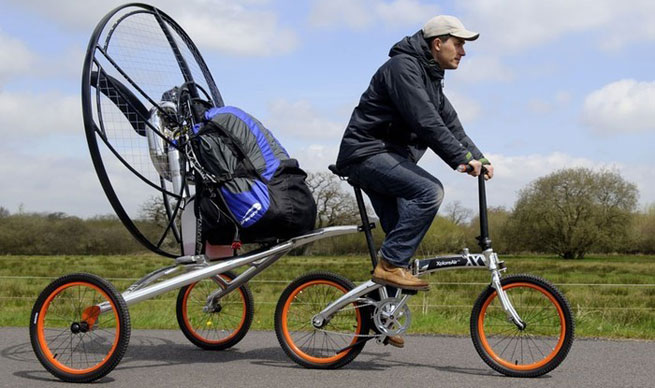Briefing: Inverted Jenny stamp to be reissued
Hapless pilot marked start of airmail service
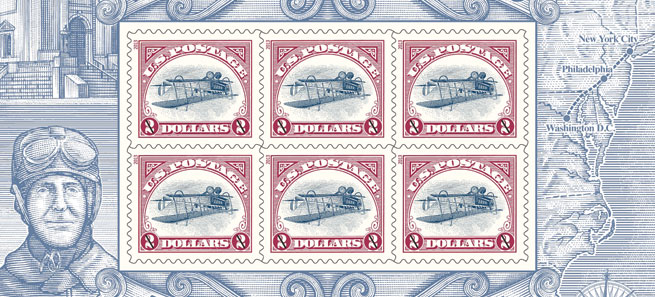
The 24-cent airmail stamp with the inverted Jenny, originally issued May 10, 1918, was scheduled to be reissued as a $2 stamp on September 22 to commemorate the opening of the William H. Gross Stamp Gallery at the Smithsonian Postal Museum near Union Station in Washington, D.C. The stamp might as well have been captioned, “Lieutenant George Boyle’s unfortunate adventures.”
Boyle was not one of the U.S. Army pilots chosen by airmail service founder Maj. Reuben H. Fleet for the first “official” flight of airmail from Washington, D.C., to New York via Philadelphia. Instead postal officials were allowed to pick two, and they chose pilots with fewer than 60 hours total flying time. Boyle was one of those. He used his influence as fiancé of the Interstate Commerce Commissioner’s daughter to make the first flight on May 15, 1918. With President Woodrow Wilson looking on, he tried to start the airplane—but it had no fuel. With that corrected, he took off, turned the wrong way and crash-landed in Waldorf, Maryland, 25 miles south of Washington. Once again using his influence, he won a second chance. This time he was given an escort pilot to get him out of the city and was told to follow the Chesapeake Bay. He crossed the bay, ran out of fuel, and landed on Maryland’s Eastern Shore. He was thrown out of the Army pilot service. “The conclusion has been reached that the best interests of the service require that Lt. Boyle be relieved from his duty,” wrote his boss, Maj. Fleet.
Other pilots that day made their trips successfully.
Email [email protected]
A single inverted Jenny stamp—in which the Curtiss JN–4 airplane appears upside down—sold for more than $977,500 in 2007. A block of four stamps sold for $2.7 million in 2005 at auction. The center image was printed first and the frame added second, so it is actually the frame that is printed upside down. Only one pane of 100 stamps was ever printed. The new stamps have a $2 denomination to make them easily distinguishable from the 24-cent originals. The original engraved dies used to produce the are being used for the new stamps.
Texas travel tips
Some suggested stops on your way to Summit
By Mike Collins
- Flying to Fort Worth for AOPA Aviation Summit, October 10 through 12? You may discover that Texas is not all flat. You’ll definitely find that Texas is big.
- Roswell International Air Center in Roswell, New Mexico, is 363 nm west of Fort Worth. While the city may be home to the International UFO Museum and Research Center, you’re much more likely to see idled airliners stored on the field than an extraterrestrial.
- Consider stopping at Midland International Airport (MAF), 250 nm west-southwest in Midland, Texas. It’s home to the Commemorative Air Force (www.commemorativeairforce.org), which is hosting its fiftieth annual airshow there October 12 and 13. Many of the nonprofit organization’s more than 150 warbirds will be on hand for the event. You’ll get a sneak peak and chance to ride in FIFI, a B–29 and other CAF airplanes in the Ghost squadron at Summit.
- Arriving from the northwest? Consider a fuel stop at Dalhart Municipal Airport in Dalhart, Texas, in the northwest corner of the state. AOPA members consistently rate the airport as friendly and accommodating. And you’ll appreciate the quick service, because you’re still 323 nm from Summit host airport Fort Worth Meacham International.Fill up on avgas: $1 gallon, Skyport, San Marcos, Texas (HYI), October 1-31
- If you’re arriving from the north, consider a stop in Wichita Falls, Texas. You’re only 84 nm from Fort Worth, and who wouldn’t want to log a landing at Kickapoo Downtown Airport?
- American Airlines will provide a 5-percent discount off any published airfare for Summit attendees (www.aopa.org/summit/transportation) Promotion Code: 11H3AI.
- If you land hungry at Fort Worth Meacham, detour north a short distance to Texas Pit B-B-Q at 324 South Saginaw Boulevard. The brisket—and everything else—is excellent. At lunchtime you’re likely to see a lot of airport people here.
- Coming from the northeast or east, you might pause at Memorial Field Airport (HOT) in the city of Hot Springs, Arkansas—263 nm from Summit. Hot Springs claims to be the only city located within a national park. The many spas in the vicinity are better suited for an overnight visit than a quick turn.
Sign up to vounteer at Summit: AOPA needs volunteers to help with parking 1,000-plus attendee aircraft, directing ground transportation, and managing the flow of people and vehicles (www.aopa.org/summit/volunteer).
Summit 2013 keynote speakers: Meet the new CEO
Mark Baker, the new president and CEO of AOPA, will provide updates on the current state of general aviation, share AOPA’s vision for the future, and present the AOPA Able Flight scholarship award during Thursday’s opening keynote for Summit 2013 in Fort Worth, Texas, October 10 through 12.
On Friday, baseball legend and pilot Ken Griffey will speak during the keynote, which also features the director and producer of Disney’s Planes. Director Klay Hall and producer Traci Balthazor-Flynn will discuss how the movie’s characters were developed, how they chose the airplanes and models, and who they went to for the research and aviation expertise. Also scheduled for Friday’s keynote is Dr. Jonathan M. Sackier, medical counsel for AOPA; Earl Weener of the NTSB; and Michael Whitaker, deputy administrator of the FAA. On Saturday, join Baker and other AOPA key leaders for “Pilot, Planes, and Pancakes” at the Meacham Airport.
The inside job
Out with the old—interior
By Thomas A. Horne
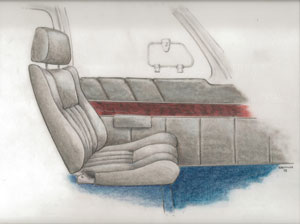 It seems like yesterday (September 2012) that we took delivery of what was then our creaky-but-serviceable Debonair. Now, its transformation is nearly complete. We put in a new windshield, tinted side windows, flap and aileron gap seals (thanks to D’Shannon Aviation), replaced the agglomeration-of-the-ages (sixties through nineties) instrument panel with the latest and greatest (thanks to principal contributors Aspen Avionics; Garmin; R.C. Allen; Alpha Systems; Electronics International; PS Engineering; CO Guardian; and master installer Santa Fe Aero Services), put in a new 70-amp alternator from National AirParts, then had KD Aviation paint Scheme Designer’s inspired design treatment that features amusing decals bearing facts about the Deb in an often humorous vein. Then we put the airplane on display at EAA AirVenture. Whew, lotta work. And travel.
It seems like yesterday (September 2012) that we took delivery of what was then our creaky-but-serviceable Debonair. Now, its transformation is nearly complete. We put in a new windshield, tinted side windows, flap and aileron gap seals (thanks to D’Shannon Aviation), replaced the agglomeration-of-the-ages (sixties through nineties) instrument panel with the latest and greatest (thanks to principal contributors Aspen Avionics; Garmin; R.C. Allen; Alpha Systems; Electronics International; PS Engineering; CO Guardian; and master installer Santa Fe Aero Services), put in a new 70-amp alternator from National AirParts, then had KD Aviation paint Scheme Designer’s inspired design treatment that features amusing decals bearing facts about the Deb in an often humorous vein. Then we put the airplane on display at EAA AirVenture. Whew, lotta work. And travel.
But now we’re entering the home stretch. Immediately after AirVenture I flew the Debonair—now renumbered N75YR in honor of the upcoming seventy-fifth anniversary of AOPA’s founding in 1939—from Oshkosh to Batavia, Ohio’s Clermont County Airport. That’s the home of Air Mod, perhaps the best of the interior shops in the entire world. “We’re dedicated to keeping these old airplanes alive,” says Air Mod President Dennis Wolter. “And this 50-year-old Debonair is a lot like plenty of airplanes we work on. It’s had a lot of neglect and deferred maintenance over the years, it hasn’t been kept clean, and corrosion is taking many of these old airplanes away from us. So we address all that—and believe me, it’s a big, expensive job.” Air Mod has been in business since 1973.
In the Debonair’s case, any deferred maintenance is deferred no more. But as Wolters’ crew dismantled the battered old interior it became clear that dirt was an issue. “Look, the glue for the side panels has turned to a tarry mess. And they used roofing shingles at one point to shore up the sidewalls! That’s all got to go,” Wolter said. “And in the belly there was a thick layer of indistinguishable dirt, mixed with what I think was an anticorrosion treatment done years ago.”
After the interior is cleaned, Air Mod will install a brand-new leather interior of its own design, complete with pilot and co-pilot headrests. There will be four-point restraint systems for the front seats, courtesy of B.A.S. Systems. For me, this will be a most welcome addition. Back in 1963 shoulder harnesses weren’t required in light aircraft. So I have been flying the airplane for some 30 hours, feeling somehow naked with just a fraying, discolored lap belt that is probably original—holding me in a seat that has virtually no lumbar support. And a wafer-thin, dry-rotted seat cushion that wants to fuse your derriere to the metal below. That, too, will be set right.
The rear seat will be reupholstered as a single-bench design, in a nod to nostalgia—and the original design. The original headliner, which unceremoniously dropped down on me and a passenger in flight, will be replaced, and so will the carpets. When Air Mod is done with it, the interior will look orders of magnitude better than it did when it rolled off the factory floor back in 1963. And it will be safer, too.
All this will take about two months. As we go to press it’s late August, so work is still in progress. But you’ll receive this magazine—the October issue—in late September. This means that work will have finished by then, and any of you going to this year’s AOPA Summit in Fort Worth will be able to see the completed interior on display there. In fact, almost all the restoration work will have been completed by then.
So far, the reports from Air Mod have been good. No corrosion under all that gunk in the belly, for example. But a bulkhead in the tailcone will need to be inspected. A minor tail strike in the distant past has bent the bulkhead, and it needs to be checked for cracks. Here’s hoping the answer is in the negative. Otherwise, it will mean repair or replacement of the bulkhead.
The perils of sitting
Oil analyses for the Debonair’s Continental IO-470 engine have turned up signs of elevated concentrations of iron, copper, chromium, nickel, and silicon. These are signs of potential wear at the cylinders, camshaft, and valve guides. The silicon is from dirt ingestion. The consensus of opinion is that these signs are consistent with an engine that has not been flown very much. From 2007, when the engine was overhauled, until 2012 the airplane flew approximately 140 hours. That’s about 28 hours a year, which is not much. Then I come along and fly it across the country and back. In the process, all the deposits accumulated from the years of sitting are now abrading and showing up in the oil. Following oil analysis firm Blackstone Laboratories’ recommendations, we’ll be changing oil at 10-hour intervals for a while. An Airwolf spin-on oil filter will be installed (the Deb’s engine has no filter, just a screen), and so will a Donaldson Company dry air filter, which should lower the silicon levels. The moral: fly often, people! And the longer the trip, the better.
Email [email protected]
On the web: Follow Tom Horne’s sweepstakes blog for updates on the renovation, as well as related news.
EAA Founder Paul Poberezny dies
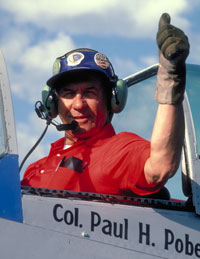 Paul Poberezny, the energetic, charismatic, and personable founder of the Experimental Aviation Association, died August 22 at the age of 91.
Paul Poberezny, the energetic, charismatic, and personable founder of the Experimental Aviation Association, died August 22 at the age of 91.
Poberezny was a military pilot for 30 years and served during World War II and Korea before retiring as a lieutenant colonel from the Wisconsin Air National Guard in 1970.
He was born in Kansas in 1921 and taught himself to fly at age 16 in a single-seat Waco glider he helped restore. He founded the EAA in the basement of his Milwaukee-area home in 1953 with wife Audrey, and they built it into a vibrant organization that now boasts 170,000 members in more than 100 countries, and its annual gathering—EAA AirVenture—is one of aviation’s premiere events.
“Paul Poberezny was a true original who embodied aviation’s best attributes of teamwork, craftsmanship, achievement, and service,” said AOPA President Craig Fuller. “He never stopped learning and never stopped striving, and he imbued EAA and all of aviation with his own optimistic and forward-looking sense of purpose.”
Poberezny designed and built a long series of original aircraft including the Pober Pixie and Acro Sport I and II, and he helped build a Pitts Special biplane that his son Tom Poberezny flew to victory in national and international competitions in the early 1970s. Tom later served as EAA president from 1989 until 2010.
Paul Poberezny attended EAA AirVenture every year and was a familiar sight waving from the chop-topped Volkswagen Beetle in which he drove throughout the sprawling airport grounds. He flew hundreds of aircraft types and logged more than 30,000 flight hours in more than 70 years of flying, but he always said that it was people—not aircraft—that inspired him.
“I’ve learned more about people through my association with aviation than I ever did about airplanes,” he said.
Stick-on checklists
Always in the pilot’s view
By Dave Hirschman
We all know that emergency checklists ought to be accessible in flight, and now there’s an easy way to make sure that’s the case in the airplanes we own or rent. Dan Shamir, a corporate pilot based in New Jersey, has developed a series of transparent, stick-on checklists for $17.95 that adhere to aircraft windows or sun visors so they stay in the pilot’s field of view.
A quick glance at the unobtrusive lists gives an overview of the steps that should be taken in case of an engine failure or in-flight fire. The lists also include the essentials for normal pre-takeoff and landing checks, as well as emergency transponder codes.
The non-adhesive material makes the lists simple to attach and remove, and they leave no residue on aircraft windshields.
I’ve attached a Thru-View checklist to the left-seat windshield of the AOPA’s Diamond DA-40, and it’s especially useful for reviewing emergency actions during the cruise flight when pilot workload is low. My only criticisms are that it doesn’t address avionics or electrical failures—scenarios that require seldom-practiced steps in a G1000-equipped DA40; and best glide speeds are curiously paired in the same box as transponder codes.
A stick-on gear-down warning also is available, as well as a plastic iPhone holder.
Email [email protected]
Getting around on the ground
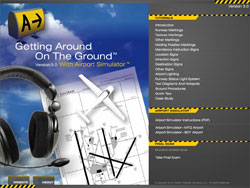 The FAA continues to harp on runway incursion avoidance, partly because it’s such an avoidable problem. Follow the signs and markings, instructions, and standard procedures and we should be OK. Unfortunately, it’s not always that easy, even though many of the problems can be traced to a lack of basic knowledge of the system.
The FAA continues to harp on runway incursion avoidance, partly because it’s such an avoidable problem. Follow the signs and markings, instructions, and standard procedures and we should be OK. Unfortunately, it’s not always that easy, even though many of the problems can be traced to a lack of basic knowledge of the system.
Getting Around on the Ground is a new computer program (Windows, Mac, or iPad) that provides an in-depth resource and simulator for every ground situation that pilots could encounter. The program is divided into two parts—lengthy chapter-based lessons that cover all the knowledge and theory of ground operations, and a simulator that allows the user to move an imaginary airplane on the surface of an airport while trying to follow air traffic control instructions.
Although there are many other quality resources available on this topic, Getting Around on the Ground is probably the most thorough one you’ll find. If you’re at all unsure about how to get from point A to point B on an airport, this is the program to try.
Price: $99
Contact: www.avtutorials.com
Flight Review Ground School
What it is: A new way to complete a flight review. WingsRealityEDU recently launched what we believe is the first online flight review ground school.
The concept is simple. Take an online course, get an endorsement, take that endorsement to an instructor for the flight portion of the flight review, fly, and then get the instructor to sign you off for another two years. Online training has been used effectively in everything from calculus to flight instructor renewals for years, so it only makes sense that we should be able to conduct our minimum one hour of ground training remotely and at our own pace.
The course is broken up into chapters that cover a number of different topics pilots need to maintain currency and safety. The presentation is basic, but the information is solid.
How much it costs: $29.95
Miscellaneous Pilot Products
By Ian Twombly
The Pen Pal
 What it is: A good cockpit light that is light, easily accessible, bright but not blinding, and easy to operate.
What it is: A good cockpit light that is light, easily accessible, bright but not blinding, and easy to operate.
What it does: Made of a soft, rubbery material, The Pen Pal slides over a pencil or thin pen, serving as both a soft grip and providing a small amount of direct light. It turns on with a press of a button on the grip, and turns off by pushing the light back up. Given that it will be forever affixed to a pen, finding one means finding the other. To make it even easier, a small hole allows it to hang from a lanyard.
How much it costs: $9.99
Classic Flight Bag
What it is: A new messenger-style bag trying to completely change the way we think about carrying around our gear.
What it does: Each hand-made bag features two large sections and two smaller, divided pockets on the inside. The outside also has a pocket for quick-grab items. It is unquestionably beautiful, but its thick leather is heavy, even empty. The buckle-style latches are better for show than work, and the bag won’t hold enough for the pilots who like to pack every chart and accessory they can find. Those issues aside, The Classic Flight Bag is one of the best options we’ve seen for pilots for whom style is important.
How much it costs: $495
Where’s the seatbelt?
Here comes another personal jet, this one a single-engine aircraft from Metal-Master in Podgórzyn, Poland, that you’ll keep in your garage and operate from grass runways. Here’s how it works.
“Your aircraft is waiting on the trailer in your garage,” the company website says. “It is enough to tow it to the nearest aerodrome, install the wings—and on the way. For takeoff and landing, the Flaris LAR 1 requires only 250 meters [820 feet] of a grassy airstrip.” Should the engine fail, the aircraft can glide nearly five nautical miles per 1,000 feet. It may be powered by a Pratt & Whitney PW615F engine, but others are under consideration.
The five-passenger, 378-knot true airspeed, single-engine jet operates at 29,000 feet and has a claimed range of 1,350 nautical miles. It has an airframe recovery parachute in case of an emergency.
The designer is Andrzej Frydrychewicz, former head engineer for PZL Warszawa-Okeciewho who created the Wilga, Raven, and the Orlik trainer that was in development when it was abandoned in 1990.
This is the first aircraft project for Metal Master. Until now it has made electrical equipment for cars and metal projects. —AKM
Web: You can see more online.
Personal jet from Poland
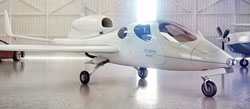 Here comes another personal jet, this one a single-engine aircraft from Metal-Master in Podgórzyn, Poland, that you’ll keep in your garage and operate from grass runways. Here’s how it works.
Here comes another personal jet, this one a single-engine aircraft from Metal-Master in Podgórzyn, Poland, that you’ll keep in your garage and operate from grass runways. Here’s how it works.
“Your aircraft is waiting on the trailer in your garage,” the company website says. “It is enough to tow it to the nearest aerodrome, install the wings—and on the way. For takeoff and landing, the Flaris LAR 1 requires only 250 meters [820 feet] of a grassy airstrip.” Should the engine fail, the aircraft can glide nearly five nautical miles per 1,000 feet. It may be powered by a Pratt & Whitney PW615F engine, but others are under consideration.
The five-passenger, 378-knot true airspeed, single-engine jet operates at 29,000 feet and has a claimed range of 1,350 nautical miles. It has an airframe recovery parachute in case of an emergency.
The designer is Andrzej Frydrychewicz, former head engineer for PZL Warszawa-Okeciewho who created the Wilga, Raven, and the Orlik trainer that was in development when it was abandoned in 1990.
This is the first aircraft project for Metal Master. Until now it has made electrical equipment for cars and metal projects. —AKM
Flaris LAR 1 Specifications
Composite construction
Wingspan 28 feet
Length 27 feet
Height 8 feet
Max gross weight Less than 3,000 pounds
Empty weight 1,433 pounds
Stall speed 62 knots indicated airspeed
First photographer in space?
A passion for aviation
John Slemp, 57, of Tucker, Georgia, has 20 years of commercial photography experience and a passion for aviation. Six years ago he turned his skills not only to airplanes but to the people in aviation, capturing astronauts and Women Airforce Service Pilots.
One of his more memorable shots came during the most recent Sun ’n Fun International Fly-In and Expo in Lakeland, Florida. It was a late-morning shoot of a Lockheed 12A in smooth air and perfect light. He remembers thinking in his excitement, “Just get it in focus.” He cites his military upbringing—his father was a Green Beret—for his interest in aviation and plans to get his pilot certificate. His ultimate goal is to become the first commercial photographer in space.
Tips for amateur photographers include not bothering to make photographs at airshows. They’re too cluttered with fuel farms, hangars, and hot-dog stands, Slemp says. He can’t control the background, so he makes arrangements at shows to take photos later, in a better environment. He “makes” photographs, rather than takes them, by assuring the background is not “messy.”
He has already gotten recognition for his work. He has an exhibition on “Early Flight to Today’s Technology” at Georgia’s second-largest museum, the Tellus Science Museum, in Cartersville, just outside Atlanta. It will run until the end of November. —AKM
Web: See more of John Slemp's work at http://www.aerographs.com.
Opinion Leaders blog launches
AOPA hosts platform to share diverse ideas about aviation
By Alyssa J. Miller
Is this the beginning of the end of VFR flying? Will AirVenture shrink to a fraction of its current size? What’s so bad about the “dive and drive” approach? Leaders in aviation and their readers are sharing their opinions on these topics and more in AOPA’s new Opinion Leaders blog.
AOPA has brought together 10 leaders in different segments of aviation ranging from business aviation to flight training to share their opinions, analysis, and forecasts of the industry. They tackle controversial topics—subjects you may have spent hours debating at the hangar with friends. Will you agree with their points of view? Share your own viewpoint in the comments area of each blog to generate a dialogue with your fellow pilots.
“We brought together a diversity of leaders from different segments of aviation to one platform for AOPA members to be able to join the conversation on issues at the heart of our community,” said AOPA Editor in Chief Tom Haines.
The blog is aimed at starting a dialogue about the future of aviation, sharing ideas, and building a sense of community. You might even find a new author you want to follow on a regular basis. (Readers should note that the opinions expressed by the bloggers do not reflect AOPA’s position on any topic.) If you find a blogger you want to follow, sign up for email alerts when a new post is added to the Opinion Leaders blog. Two posts will be added to the blog each week.
The 10 writers on the blog are: Jamie Beckett, Florida Polk Aviation Alliance; Amy Laboda, editor of Women In Aviation magazine; Jolie Lucas, vice president of the California Pilots Association; Jack Olcott, past president of the National Business Aviation Association; John L. Petersen, chairman of the Lindbergh Foundation; Dan Pimentel, who writes the Airplanista Aviation Blog; Rod Rakic, cofounder of OpenAirplane; Ron Rapp, a Southern California-based charter pilot; Martin Rottler, a lecturer at The Ohio State University Center for Aviation Studies; and Max Trescott, the 2008 National CFI of the Year.
